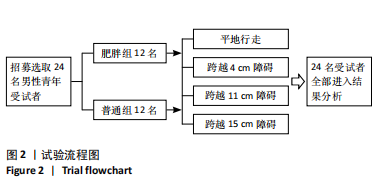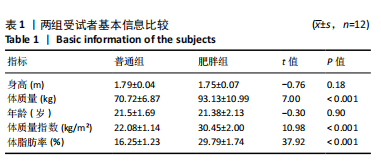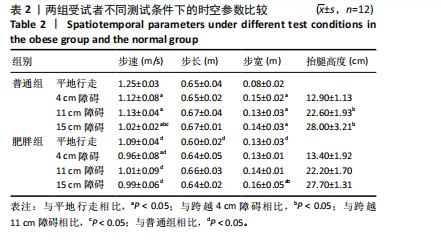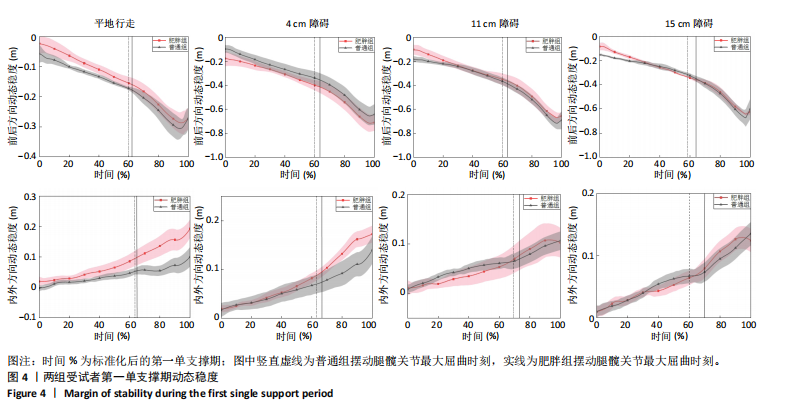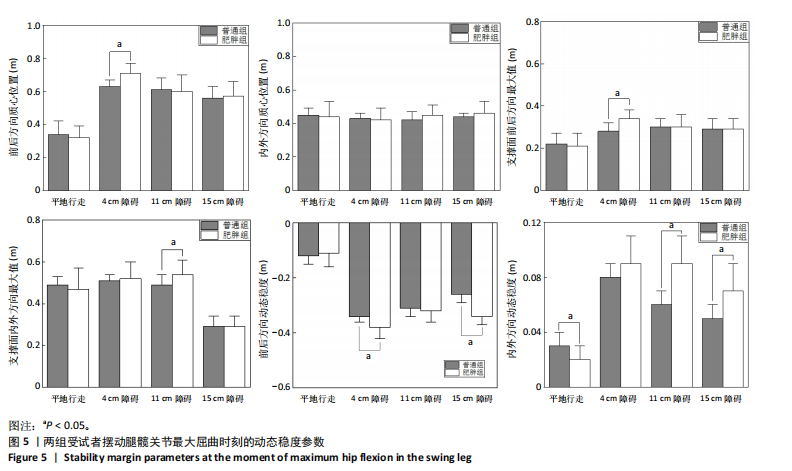[1] 黄守清, 许艺惠, 尹莲花. 414例不同年龄男女间平衡能力及身体质量指数的差异分析[J]. 山东体育科技,2016,38(2):52-55.
[2] MACIE A, MATSON T, SCHINKEL-IVY A. Age affects the relationships between kinematics and postural stability during gait. Gait Posture. 2023;102:86-92.
[3] HARRISON K, KWON YU, SIMA A, et al. Inter-joint coordination patterns differ between younger and older runners. Hum Mov Sci. 2019;64: 164-170.
[4] HATZITAKI V, AMIRIDIS IG, ARABATZI F. Aging effects on postural responses to self-imposed balance perturbations. Gait Posture. 2005;22(3):250-257.
[5] 张阳, 严凤清, 郭小莉, 等. BMI和性别对大学生静动态平衡能力影响的研究[J]. 吉林体育学院学报,2021,37(5):83-87.
[6] 曾玉冰. 男性肥胖大学生步行与慢跑步态特征分析[D]. 大连: 大连理工大学,2021.
[7] CHARDON M, BARBIERI F A, PENEDO T, et al. The effects of experimentally-induced fatigue on gait parameters during obstacle crossing: A systematic review. Neurosci Biobehav Rev. 2022;142: 104854.
[8] CHO H, HEIJNEN MJ, CRAIG BA, et al. Falls in young adults: The effects of sex, physical activity, and prescription medications. PLOS One. 2021;16(4):e0250360.
[9] STRUBHAR AJ, PETERSON ML, ASCHWEGE J. The effect of text messaging on reactive balance and the temporal and spatial characteristics of gait. Gait Posture. 2015;42(4):580-583.
[10] SONG Q, ZHOU J, SUN W, et al. Long-term tai chi exercise increases body stability of the elderly during stair ascent under high and low illumination. Sports Biomech. 2018;17(3):402-413.
[11] MIAN OS, NARICI MV, MINETTI AE, et al. Centre of mass motion during stair negotiation in young and older men. Gait Posture. 2007;26(3): 463-469.
[12] NOVAK A, BROUWER B. Sagittal and frontal lower limb joint moments during stair ascent and descent in young and older adults. Gait Posture. 2011;33(1):54-60.
[13] GONCALVES G, SELISTRE L, PETRELLA M, et al. Kinematic alterations of the lower limbs and pelvis during an ascending stairs task are associated with the degree of knee osteoarthritis severity. Knee. 2017; 24(2):295-304.
[14] QU X, HU X. Lower-extremity kinematics and postural stability during stair negotiation: Effects of two cognitive tasks. Clin Biomech. 2014; 29(1):40-46.
[15] HOF AL, GAZENDAM MG, SINKE WE. The condition for dynamic stability. J Biomech. 2005;38(1):1-8.
[16] GILL SV, HUNG YC. Effects of overweight and obese body mass on motor planning and motor skills during obstacle crossing in children. Res Dev Disabil. 2014;35(1):46-53.
[17] 郑慧芬, 孙威, 宋祺鹏, 等. 手机任务介入对下楼梯行走动态稳定性的影响[J]. 中国运动医学杂志,2021,40(7):528-535
[18] 黄尚军, 伍勰, 黄睿, 等. 脑卒中伴随膝伸肌痉挛者跨越障碍的运动控制策略研究[J]. 医用生物力学,2021,36(S1):201.
[19] 陈岩, 孙威, 马腾, 等. 有跌倒史老年人跨越障碍步态特征的研究[J]. 山东体育学院学报,2014,30(5):62-64.
[20] 孟站领, 张庆来, 苑玲伟, 等. 不同跌倒风险老年人跨越障碍前后足底压力特征[J]. 医用生物力学,2022,37(4):741-747.
[21] KIM D, LEWIS CL, GILL SV. The effect of obesity on whole-body angular momentum during steady-state walking. Gait Posture. 2022;94: 93-101.
[22] LEWINSON RT, MADDEN R, KILLICK A, et al. Foot structure and knee joint kinetics during walking with and without wedged footwear insoles. J Biomech. 2018;73:192-200.
[23] BLOEM BR, GRIMBERGEN YA, VAN DIJK JG, et al. The” posture second” strategy: A review of wrong priorities in parkinson’s disease. J Neurol Sci. 2006;248(1):196-204.
[24] 王莉, 于卫华, 徐忠梅. 社区老年人双重任务行走步态特征与跌倒的关系研究[J]. 护理学杂志,2016,15(1):76-79.
[25] 杨凤娇, 王芗斌, 侯美金, 等. 三维步态分析比较青年人与老年人双任务下步态特征的差异[J]. 中国组织工程研究,2021,25(3):344-349.
[26] LEE HJ, CHOU LS. Balance control during stair negotiation in older adults. J Biomech. 2007;40(11):2530-2536.
[27] 梁雷超, 黄灵燕, 伍勰, 等. 膝骨关节炎对女性老年人步行动态稳定性的影响[J]. 体育科学,2016,36(3):61-66.
[28] PEEBLES AT, REINHOLDT A, BRUETSCH AP, et al. Dynamic margin of stability during gait is altered in persons with multiple sclerosis. J Biomech.2016;49(16):3949-3955.
[29] HINMAN RS, BENNELL KL, METCALF BR, et al. Balance impairments in individuals with symptomatic knee osteoarthritis: a comparison with matched controls using clinical tests. Rheumatology. 2002;41(12):1388-1394.
[30] MCANDREW YP, DINGWELL J. Voluntary changes in step width and step length during human walking affect dynamic margins of stability. Gait Posture. 2012;36(2):219-224.
[31] ARAMPATZIS A, KARAMANIDIS K, MADEMLI L. Deficits in the way to achieve balance related to mechanisms of dynamic stability control in the elderly. J Biomech. 2008;41(8):1754-1761.
[32] 曾照宏, 薛奥传, 王会会, 等. 肥胖大学生膝关节肌力特征及动态平衡的关系[J]. 体育科技文献通报,2022,30(9):120-123.
[33] BOEKA AG, LOKKEN KL. Neuropsychological performance of a clinical sample of extremely obese individuals. Arch Clin Neuropsych. 2008; 23(4):467-474.
[34] DIAMOND A, LEE K. Interventions shown to aid executive function development in children 4–12 years old. Science. 2011;333(6045): 959-964.
[35] GREVE J, ALONSO A, BORDINI AC, et al. Correlation between body mass index and postural balance. Clinics (Sao Paulo). 2007;62(6):717-720.
[36] GILL SV, HUNG YC. Influence of weight classification on children stepping over obstacles. Am J Phys Med Rehabil. 2012;91(7):625-630.
[37] LIU ZQ, YANG F. Obesity may not induce dynamic stability disadvantage during overground walking among young adults. PLOS ONE. 2017; 12(1): e0169766.
[38] ESPY DD, YANG F, BHATT T, et al. Independent influence of gait speed and step length on stability and fall risk. Gait Posture. 2010;32(3): 378-382.
[39] CURTZE C, BUURKE TJW, MCCRUM C. Notes on the margin of stability. J Biomech. 2024;166:112045.
[40] DONELAN J, KRAM R, KUO A. Mechanical and metabolic determinants of the preferred step width in human walking. Proc Biol Sci. 2001; 268(1480):1985-1992.
[41] HERSSENS N, CRIEKINGE TV, SAEYS W, et al. An investigation of the spatio-temporal parameters of gait and margins of stability throughout adulthood. J R Soc Interface. 2020;17(166):20200194.
[42] FORNER CORDERO A, KOOPMAN HF, VAN DER HELM FC. Multiple-step strategies to recover from stumbling perturbations. Gait Posture. 2003; 18(1):47-59. |
